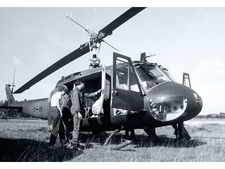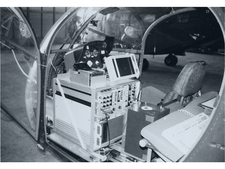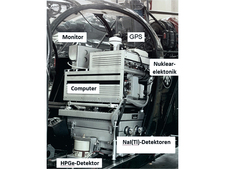-
Topics
subnavigation
Topics
Electromagnetic fields
- What are electromagnetic fields?
- Static and low-frequency fields
- Radiation protection relating to the expansion of the national grid
- High-frequency fields
- Radiation protection in mobile communication
Optical radiation
Ionising radiation
- What is ionising radiation?
- Radioactivity in the environment
- Applications in medicine
- Applications in daily life and in technology
- Effects
- What are the effects of radiation?
- Effects of selected radioactive materials
- Consequences of a radiation accident
- Cancer and leukaemia
- Genetic radiation effects
- Individual radiosensitivity
- Epidemiology of radiation-induced diseases
- Ionising radiation: positive effects?
- Risk estimation and assessment
- Radiation protection
- Nuclear accident management
- Service offers
-
The BfS
subnavigation
The BfS
- About us
- Science and research
- Laws and regulations
- BfS Topics in the Bundestag
- Links
Airborne gamma spectrometry - How it all began
- In the early 1970s, the developing and testing of measurement methods for monitoring emissions and immissions from nuclear installations began.
- After the Chernobyl reactor accident, the research in the field of airborne gamma spectrometry was intensified.
- As a result of previous investigations, various measurement system prototypes were developed for regular use in helicopters of the German Federal Police.
- The quality of the current measurement system has been confirmed during several international comparative measurements.

![]() First tests with the German Federal Armed Forces
First tests with the German Federal Armed Forces
In the early 1970s, the then Institute of Radiation Hygiene (ISH) of the German Federal Health Agency (BGA) - part of the Federal Office for Radiation Protection (BfS) since 1989 - began to develop and to test measurement methods for monitoring emissions and immissions from nuclear installations.
1984: Binational programme on airborne gamma spectrometry
In 1984, the German Institute of Radiation Hygiene and the National Institute for Public Health and the Environment in the Netherlands agreed on a joint programme for testing gamma spectrometry measurement systems in aircraft for measuring soil contamination.
1986: First joint measurements by Dutch and German measurement teams
Dutch and German measurement teams carried out their first joint measurements at Hilversum Airport in the Netherlands. They determined the location of radioactive sources using semiconductor detectors.
Subsequently, the German Federal Health Agency (since 1989: Federal Office for Radiation Protection (BfS)) carried on the investigations in the research project "Development and practical application of quick methods for the detection of accidental environmental contamination
" funded by the Federal Environment Ministry (BMU).
After the Chernobyl reactor accident, the German Federal Health Agency (since 1989: BfS) intensified the research in the field of airborne gamma spectrometry.
1988: Uncontrolled re-entry of the Soviet satellite Kosmos 1900
In the autumn of 1988, the satellite Kosmos 1900 - a nuclear-powered satellite - was brought down by the Soviet Union. Ten years before that, during a similar manoeuvre, an incident occurred because the reactor core of the affected satellite (Kosmos 954) failed to separate and could not be lifted into a safe orbit before re-entry into the Earth's atmosphere as had been planned.
In the course of the preparations for the uncontrolled re-entry of Kosmos 1900 - for which a similar incident could not be excluded - valuable experience was gained during the flight testing of various measurement systems. In the process, the German Federal Health Agency (since 1989 BfS) was supported by the aviation squadron of the German Federal Border Police (now Federal Police) and the German Federal Armed Forces.
Since then, the cooperation with the Federal Police has been intensified by annual national measurement exercises.
Airborne gamma spectrometry measurement systems used from 1988 to 1992

![]() Prototype 1 - Laboratory measurement system in an Alouette II helicopter
Prototype 1 - Laboratory measurement system in an Alouette II helicopter
As a result of previous investigations, various measurement system prototypes were developed for regular use in Alouette II helicopters of the German Federal Border Police (now Federal Police).
Prototype 1
Prototype 1 was based on the application of a high-purity germanium semiconductor detector. The data that could be collected by this measurement system were spectra, that is to say raw data, from which the relevant information had to be calculated in retrospect.
All components of prototype 1 were from the inventory of the German Federal Health Agency (since 1989 BfS) laboratory. In other words, this prototype was a provisional arrangement and was therefore soon replaced by prototype 2.
Prototype 2

![]() Prototype 2 - Measurement system with a recorder in an Alouette II helicopterII
Prototype 2 - Measurement system with a recorder in an Alouette II helicopterII
Prototype 2 comprised three large-volume scintillation detectors (NaI(Tl)) and a 4-channel recorder used for collecting measurement data on the three radionuclides determined beforehand and data on the flight altitude.
The on-board BfS staff member recorded all important additional information about measurement sites showing radiologically significant data directly on the recorder strip.
As both of the aforementioned prototypes did not have GPS yet, the whole measurement flight was additionally documented by video recording for being able to allocate the recorded measurement signal to a point on the terrain or even to a certain object.
1993 to 2004: Airborne gamma spectrometry measurement system MARS
In order to keep up with the current state of science and technology in that task area, the prototypes were further developed. In 1993, BfS staff members established a computer-aided measurement system for the detection of nuclear radiation (MARS). It was made up of
- an industrial computer with integrated measurement cards,
- three scintillation detectors (NaI(Tl)), the individual measurement signals of which were combined into a sum signal, and
- a high purity semiconductor detector.
2004: Airborne gamma spectrometry measurement system ARME

![]() Measurement system ARME (State of 2015)
Measurement system ARME (State of 2015)
Starting from the year 2004, the Federal Police gradually replaced their Alouette II helicopters by EC 135 helicopters. The BfS developed a new measurement system for this type of helicopter.
This more efficient measurement system called Airborne Radiation Measuring Equipment (ARME)
- with four independently operating large-volume scintillation detectors (NaI(Tl)) as well as
- a high resolution semiconductor detector
was designed by the BfS. The quality of the new measurement system has been confirmed during several international comparative measurements.
State of 2018.04.20



